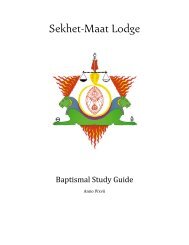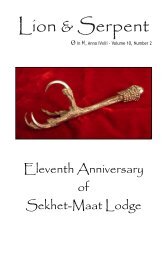Lion & Serpent - Sekhet-Maat Lodge
Lion & Serpent - Sekhet-Maat Lodge
Lion & Serpent - Sekhet-Maat Lodge
You also want an ePaper? Increase the reach of your titles
YUMPU automatically turns print PDFs into web optimized ePapers that Google loves.
continued from previous page...<br />
“There was a sacred bull in this<br />
labyrinth, quite white. At the spring<br />
festival they sacrificed twelve virgins<br />
to him.<br />
“‘Here the brutish act appeared:<br />
Pasiphae<br />
being covered by the bull in the cow’s<br />
place’<br />
Aeneid VI<br />
“They wanted to<br />
get a Minotaur, an<br />
incarnation of the<br />
sun, a Messiah.<br />
They said they had<br />
one, but they<br />
hadn’t.” 3<br />
Here the Legend of<br />
Pasiphae is given by<br />
Crowley as a historical<br />
example of “procreation<br />
other than normal.” There<br />
is reference to the sacred<br />
white bull, as well as the<br />
Apis bull that was<br />
worshipped in Egypt,<br />
another “legend of the<br />
Bull gods.” The virginity of twelve women<br />
was sacrificed each Spring in hope that one<br />
would bear a Minotaur, an offspring of<br />
“magical character.”<br />
The idea that “either the father of the child<br />
should be a symbol of the sun, or the mother<br />
a symbol of the moon” is also supported by<br />
the Legend of Pasiphae. The Minotaur’s<br />
actual Greek name was Asterius, meaning<br />
“of the Sun,” and Pasiphae, “she who shines<br />
for all,” was originally a Cretan Moon<br />
3 Ibid. Note that the quote from the Aeneid originally<br />
appeared in Greek in Crowley’s text; for convenience I<br />
have given the Robert Fitzgerald translation included in<br />
the notes of the Equinox 4:2 version.<br />
4 See Robert Graves The Greek Myths for more on the<br />
historical basis for the Legends of Pasiphae and the<br />
Minotaur.<br />
14<br />
goddess. 4 The virgins are twelve in number<br />
to represent the twelve signs of the zodiac<br />
through which the Sun travels on his yearly<br />
journey, suggested here as starting in the<br />
spring with Taurus.<br />
This symbolism of the Legend of Pasiphae<br />
is also found in the Hierophant trump. The<br />
Hierophant is Osiris, or, taken in context<br />
with the bull that supports him, Serapis.<br />
The bull is focused on the loins of the<br />
Woman, who is Isis, holding the lunar<br />
crescent that identifies her with the Moon.<br />
It is this relationship between the bull and<br />
the Woman that constitutes the “distinctly<br />
sadistic aspect to this card.”<br />
The Legend of<br />
Pasiphae is also<br />
interpreted at the<br />
beginning of the<br />
16th Aethyr of The<br />
Vision and the Voice,<br />
where we begin to<br />
understand its<br />
relevance:<br />
“There are faint<br />
and flickering<br />
images in a misty<br />
landscape, all very transient.<br />
But the general impression is of a<br />
moonrise at midnight, and a crowned<br />
virgin riding upon a bull.<br />
“And they come up into the surface of<br />
the stone. And she is singing a chant of<br />
praise: Glory unto him that hath taken<br />
upon himself the image of toil. For by<br />
his labour is my labour accomplished.<br />
For I, being a woman, lust ever to mate<br />
myself with some beast. And this is<br />
the salvation of the world, that always<br />
I am deceived by some god, and that<br />
my child is the guardian of the labyrinth<br />
that hath two-and-seventy paths.” 5<br />
5 Equinox Vol. 4, No. 2, page 125.<br />
continued on page 15...









